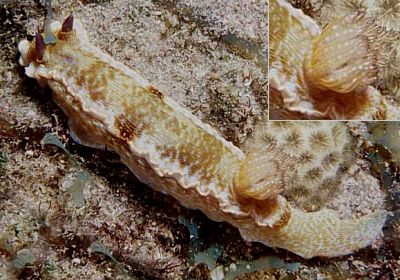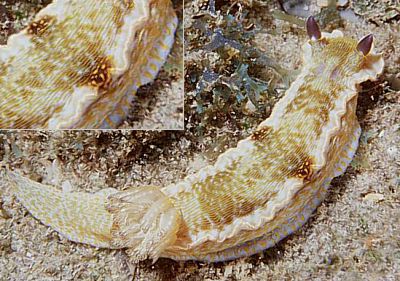Hypselodoris acriba or H. edenticulata
August 21, 2001
From: Anne DuPont


Note added 31 May 2010: This species has recently been named H. juliae.
Hi Bill,
Is this a color form of Hypselodoris picta edenticulata? or is it Hypselodoris acriba?
It was photographed off Boca Raton, Florida, USA, in about 10 feet of water on the sand. This one was about 2 1/2 inches long and was very active. We also found a pair about 1 inch each long on a purple sponge. Photographed on July 29, 2001.
Thank you again for all the work you do on the forum.
Cordially,
Anne DuPont
adupont@gate.net
DuPont, A., 2001 (Aug 21) Hypselodoris acriba or H. edenticulata. [Message in] Sea Slug Forum. Australian Museum, Sydney. Available from http://www.seaslugforum.net/find/5111Dear Anne,
Thanks very much for sending these interesting photos. Did you by chance photograph it on the purple sponge as well? That would be really interesting. It certainly looks like the animal identified in Paul Humann's book as Hypselodoris acriba but that photo is rather different from the published description of H. acriba which is of an animal much like Dave Behren's photo on the Forum. One distinctive feature in your photos are the dark patches midway down each side on the mantle with yellow spots. These spots aren't present in Behren's photo or mentioned by the Marcuses in the original description. Also Marcus describes the gills as having 'bases of gills brick red, tips yellowish' which is the same as Behren's photo. In your photo the gills are translucent clear with a row of white spots up the outer rachis. The gills also seems to have branched purplish tips.
Checking the literature, what really amazes me is that we know so little about Hypselodoris acriba. It was described on a single preserved specimen and almost no other published record exists with any information on colour variation etc. It is the same with Hypselodoris ruthae and almost every chromodorid from the west Atlantic.
Basically this may be H. acriba but unless someone with a lot of unpublished knowledge can give us some advice on its colour variation, I really can't say much more.
Best wishes,
Bill Rudman
Related messages
-
Hypselodoris juliae from Brazil [2]
From: Peter Wirtz, June 3, 2010 -
Hypselodoris juliae from Brazil [1]
From: Vinicius Padula, May 31, 2010 -
Hypselodoris sp. 4 - Post Mating
From: Linda Ianniello, May 16, 2003 -
Hypselodoris sp. 4 eggs
From: Linda Ianniello, September 27, 2002 -
Food of Hypselodoris sp. 4
From: Anne DuPont, October 6, 2001 -
Re: Hypselodoris sp. 4 from Florida
From: Linda Ianniello , October 5, 2001 -
Food of Hypselodoris sp. 4
From: Anne Dupont, September 25, 2001 -
Hypselodoris acriba or H. edenticulata?
From: Anne DuPont, September 25, 2001
